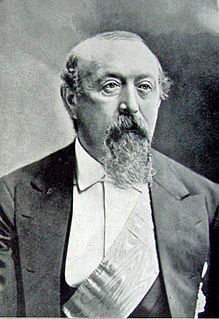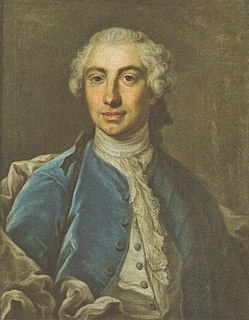
Christian Emil Krag-Juel-Vind-Frijs was a Danish nobleman and politician. He was Council President of Denmark from 1865 to 1870 as the leader of the Frijs Cabinet.

The Hørring cabinet was formed on 7 August 1897 and consisted entirely of members of the party Højre. It was created following Tage Reedtz-Thott's resignation as Council President, when Hugo Egmont Hørring of the conservative party Højre became the leader of the new Danish cabinet, replacing the Cabinet of Reedtz-Thott.

Halsted Priory, formerly a small Benedictine house, is a manor house and estate located close to Nakskov on the island of Lolland in southeastern Denmark. The estate was renamed Juellinge when the Barony of Juellinge was restored for Jens Juel-Vind in 1721, but its old name was restored when the barony was dissolved in 1921. Holsted Priory is still owned by the Krag-Juel-Vind-Frijs family. The Neo-Gothic main building is from 1847-49. It is flanked by Halsted Church to the north and the old main building from 1591 to the south. The old main building has been renovated with support from Realdania and is now operated as a local cultural centre. The Baroque-style park covers approximately 6.5 hectares of land. The estate is also home to a golf club.

Sophia Magdalena Krag-Juel Vind, née von Gram (1734–1810), was a Danish Salon holder, landowner and noble. She is considered to have exerted considerable political influence in Danish politics during the late 18th century.
Events from the year 1724 in Denmark.
Events from the year 1776 in Denmark.

Gammel Køgegård is a manor house located just west of Køge, Denmark.

Barchmann Mansion is a Baroque style town mansion overlooking Frederiksholm Canal in central Copenhagen, Denmark. Built in the early 1740s to designs by Philip de Lange, it is also known as the Wedell Mansion after the current owner. It was listed in the Danish registry of protected buildings and places in 1918. An extension from 1748 is now home to Johan Borup's Folk High School.
Folketing elections were held in Denmark on 12 October 1866, following the introduction of a new constitution. The National Liberal Party and the National Left emerged as the largest factions, winning 20 seats each. Christian Emil Krag-Juel-Vind-Frijs remained Prime Minister.
Folketing elections were held in Denmark on 4 June 1866. The National Left emerged as the largest faction, winning 30 of the 101 seats. Christian Emil Krag-Juel-Vind-Frijs remained Prime Minister.

Halsted Church stands in the little village of Halsted some 6 km east of Nakskov on the Danish island of Lolland. Dating from the second half of the 12th century, the church has a Romanesque chancel and nave, a large burial chapel from 1636 and a tower from 1877. The church was closely associated with Halsted Priory, which has not survived.

Frijsenborg is a manor house and estate near Hammel, 27 km (17 mi) northwest of Aarhus in Jutland, Denmark. The first manor on the site known as Jernit was built by Valdemar Parberg in 1583. After the statesman Mogens Friis acquired the property in 1672, the manor was rebuilt at the end of the 17th century. In the 1860s, it was considerably expanded and redesigned in the Renaissance style.
The surname Krag may refer to:
Folketing elections were held in Denmark on 22 September 1869. The Mellem Party emerged as the largest factions, winning 27 seats. Christian Emil Krag-Juel-Vind-Frijs remained Prime Minister.

Jens Juel-Vind, baron of Juellinge, was a Danish chamberlain and landowner.

Jens Krag-Juel-Vind, Baron of Juellinge, was a Danish nobleman, Supreme Court justice and landowner.

The Minister of War was the Danish minister responsible for the administration of the Royal Danish Army.
Vind is a Danish surname meaning wind. Notable people with this surname include:

The Minister for the Navy was the Danish minister responsible for the administration of the Royal Danish Navy.












